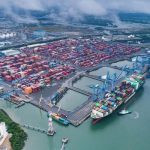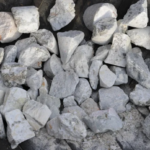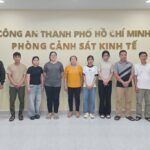The Cần Giờ “super” port is poised for historic opportunities with “heavenly timing, geographical advantage, and human harmony” as the Central Government and Ho Chi Minh City consistently take concrete and drastic actions for implementation.
Given the “Green Light”
Recently, Deputy Prime Minister Trần Hồng Hà chaired a meeting with several ministries, sectors, and localities regarding the draft detailed planning for a group of seaports, wharves, piers, buoys, and water areas for the period of 2021–2030, with a vision towards 2050, and also listened to a report on the investment policy for the Cần Giờ International Transshipment Port project.
Previously, the proposal for the Cần Giờ International Transshipment Port construction had passed the appraisal round of the Ministry of Transport. During the meeting on June 17, 100% of the members of the Appraisal Council agreed on the necessity of establishing the proposal and voted for its approval. At the second appraisal meeting on August 16, the Appraisal Council unanimously passed the minutes of the meeting on the “Proposal for the Study and Construction of Cần Giờ International Transshipment Port.” After two serious appraisal rounds, on August 20, the Ministry of Transport submitted a report to the Prime Minister on the appraisal results of the proposal. This is another important step towards getting approval for the construction of the largest transshipment port in Vietnam.
In the appraisal report, the Ministry of Transport affirmed that the proposal for the Cần Giờ International Transshipment Port construction has sufficient legal basis and is in line with the policies of the Party, National Assembly, and Government. The People’s Committee of Ho Chi Minh City has basically fulfilled the task of receiving and explaining in detail the opinions of the ministries, localities, experts, and members of the appraisal council.
The Ministry of Transport agreed with the proposal’s objective of promoting the Cần Giờ port area into an international transshipment center, attracting reputable shipping and transportation companies, and soon turning the Cái Mép river gate into an international transshipment gateway. It also aims to establish a duty-free area associated with the international transshipment port while ensuring the protection of sovereignty over borders and islands and maintaining social order and safety.
According to the Ministry of Transport, the proposal includes preliminary calculations of investment costs and resources and provides assessments and suggestions for implementation measures, along with a preliminary identification of environmental impacts.
The proposal for the construction of the Cần Giờ International Transshipment Port has been meticulously and passionately studied by Ho Chi Minh City over the past time. Since the beginning of 2023, the city has established the proposal, comprehensively received feedback through workshops, and widely consulted the opinions of ministries, sectors, localities, agencies, and experts and scientists.

Prime Minister Phạm Minh Chính and the delegation, along with Ho Chi Minh City’s leaders, survey the expected location of the Cần Giờ International Transshipment Port (in Cần Giờ district, Ho Chi Minh City) Photo: NGUYỄN PHAN
Formation of an International Transshipment Port Cluster
According to a report by the Ho Chi Minh City Institute for Development Studies (HIDS) related to the green-oriented marine economic development in Cần Giờ, in the field of international transshipment ports and logistics services, constructing and operating the Cần Giờ port as Vietnam’s first “green port” will contribute to economic growth.
One possible direction is to establish a free trade area linking the Cần Giờ seaport with the Cái Mép Hạ seaport in Bà Rịa-Vũng Tàu province. Along with the construction of the international transshipment port, there should be a strong development of accompanying logistics services, thus making essential contributions to the local economy, creating a ripple effect on other industries, and promoting the application of science and technology.
Commenting on the proposal to build the Cần Giờ International Transshipment Port, experts expect this “gold mine” to help Ho Chi Minh City advance towards the vast ocean, maintain its role as the logistics center of Southeast Asia and Asia, similar to Hong Kong (China) and Singapore. It will also bring budget revenue, create jobs, promote the completion of surrounding infrastructure, and attract “big players” to invest and develop in the city.
Having provided feedback on the proposal several times, economist Dr. Trần Du Lịch expressed his agreement and emphasized the necessity of immediately constructing the Cần Giờ International Transshipment Port. Especially with Ho Chi Minh City now having a specific mechanism and policy from Resolution 98/2023 of the National Assembly, this opportunity should be seized to implement the proposal because if it is missed, it may not come again.

The Cần Giờ International Transshipment Port will be constructed in the Con Chó islet, Thạnh An commune, Cần Giờ district, Ho Chi Minh City, with an area of over 570 hectares. Photo: HOÀNG TRIỀU
According to Dr. Trần Du Lịch, this is an opportunity to turn the cluster of ports No. 4 – including the Cái Mép – Thị Vải port (in Bà Rịa-Vũng Tàu province) and Cần Giờ (in Ho Chi Minh City) – into an international transshipment center. This is because the Cần Giờ port will not affect or compete with the Cái Mép – Thị Vải port; instead, the two will form a complementary port system, creating a shared ecosystem to develop a logistics center that can compete with other ports in the region.
Sharing the same view, Prof. Dr. Trần Đình Thiên, former Director of the Vietnam Economic Institute, emphasized that this is a historic opportunity that must be seized to maximize the potential of other seaports.
Economist Dr. Đinh Thế Hiển assessed that if there is a strategic investor with sufficient capital to implement the port project, it would only meet about 30% of the requirements for success. Considering the geographical location and topography of Cần Giờ, 30%-40% of the conditions for the project’s success also depend on the planning of infrastructure connecting the port and the surrounding area, especially since Cần Giờ lacks the fundamental infrastructure compared to ports like Cái Mép – Thị Vải and Vân Phong. Therefore, the project of the Cần Giờ International Transshipment Port needs outstanding advantages and special factors to attract attention.
“In the medium and long-term strategy, industrial parks and urban areas in the central area of Ho Chi Minh City will be relocated to the outskirts or developed with high technology associated with urbanization instead of traditional industrial parks. At this point, having a super international port like Cần Giờ to maintain revenue, replacing the Tân Thuận and Sài Gòn ports, is a strategy worth considering,” analyzed Dr. Đinh Thế Hiển.
Awakening the “Reserved Asset”
Chairman of the Ho Chi Minh City People’s Committee, Phan Văn Mãi, affirmed that the city would not compromise at all costs to carry out the project of the Cần Giờ International Transshipment Port. Instead, there will be a harmonious consideration between economic-social interests and environmental protection. The awakening of the “reserved asset” in Cần Giờ will be carried out by the city with the principle of exploiting its potential while maximizing the protection of the “lung.”
Experts noted that as Ho Chi Minh City is the center of the key economic region of the South, the Cần Giờ International Transshipment Port should also be placed in the context of connecting with this extensive region. Therefore, to make the proposal to build the Cần Giờ “super” port feasible and have a spillover effect on other sectors of the economy, it requires not only attracting resources in terms of capital but also many other factors related to the planning of transportation infrastructure and regional connectivity.
Unlocking New Maritime Routes: Chu Lai Port Expands Its Horizons
The Chu Lai Port has expanded its reach with a brand-new direct service to major ports in India, China, and other Asian countries. This exciting development opens up a world of opportunities, offering seamless connectivity and efficient trade routes to and from dynamic markets in the region. With this expansion, the port solidifies its position as a key player in international trade, providing a gateway to Asia that is hard to rival.
Adjusting the holistic planning of scientific seaport system, synchronization
The overall planning of the port system needs to determine the initial land and water space, ready for implementation after being approved for adjustment. This is the guidance of Deputy Prime Minister Tran Hong Ha at the meeting to hear the report on the adjustment of the overall planning for the development of Vietnam’s port system for the period 2021-2030, with a vision until 2050.










































